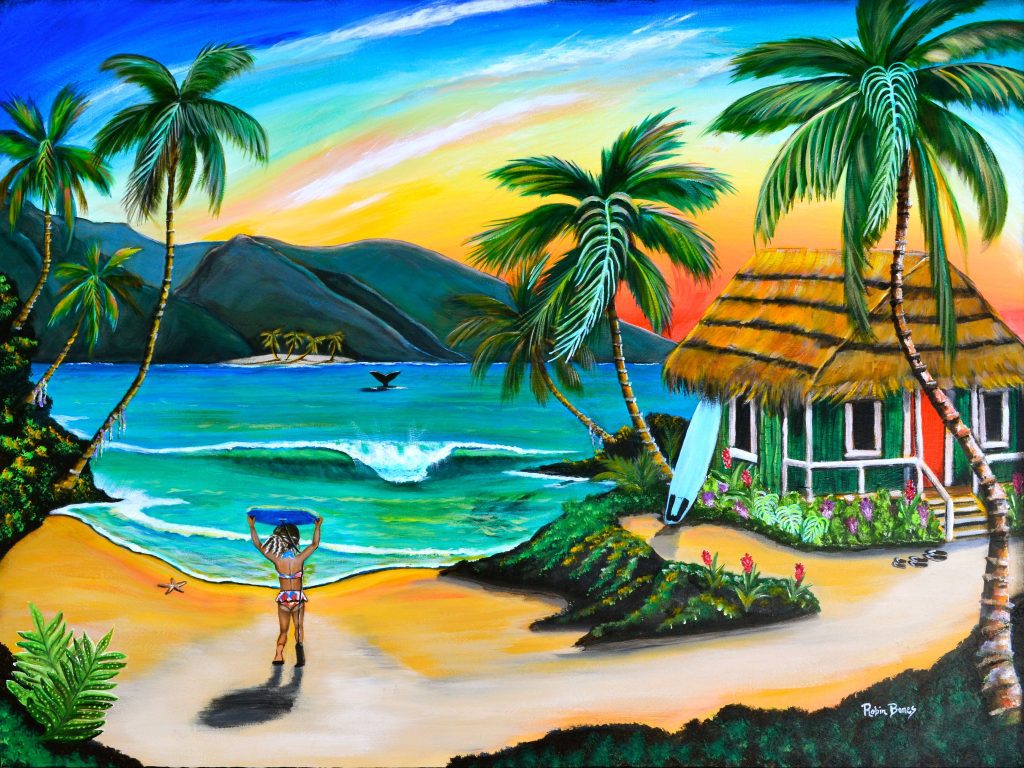Discover hawaiian art that evokes tropical flowers, tranquil beaches and the sound of the ukulele. Explore this collection from a variety of artists and galleries throughout Hawaii.
Prior to European contact, petroglyph makers carved powerful cultural objects like ships, cannons and muskets, demonstrating Hawaiians’ active role in their interactions with the new, foreign cultures they encountered.
Origins
The arts of Hawaii came close to being lost after two hundred years of upheaval from new cultures brought by outsiders. Some art forms have been preserved by dedicated experts who take great pains to research, learn, and reproduce them.
Petroglyphs are pecked or chipped into the surface of a rock and may be found on flat pahoehoe surfaces, upright pahoehoe slabs, and chilled lava surfaces. Some petroglyphs appear to mark political boundaries or major trails, but the meaning of a petroglyph cannot be understood at a surface level unless it is considered through its cultural metaphors.
Kii are symbolic statues that represent akua (Gods, deified ancestors, or talismans). They can be carved from wood, bones, teeth, sea urchin spines, feathers, and human hair, but they are most often etched into the surface of obsidian petroglyphs. This example depicts a ship and a papamu. It is a good example of the way Hawaiians incorporated European items, including weapons and ships, into their culture. It also shows how Hawaiian Ali’i used petroglyphs to advance their conquest aims.
Forms
A Hawaii-based artist combines elements of local life to create beautiful, evocative art. She captures the power of a sunset over the Pacific Ocean, canoes sailing under stars and calm blankets of cloud, native flora and sea animals, as well as cultural elements such as hook-shaped whale ivory pendants and lei.
Her artwork explores the ways in which various overlaid systems of land division and property trouble connections between traditional indigenous and settler cultures. She is also interested in the ways in which Hawaiians have maintained and adapted traditional cultural practices while addressing contemporary challenges and advancing their aims and ambitions.
Moai kavakava, smaller wooden figures similar to those carved on Rapa Nui, are another example of a conflation of pre-European contact art and objects that came with Cook’s arrival. These sculptural objects often have elongated earlobes, pronounced brow ridges, and carved chins that link them to notions of genealogical heritage. The skeletal forms emphasize the backbone and ribs, and many have inlaid bone, shell, and obsidian eyes. They are erected on ahu (ceremonial platforms) and found scattered along the island’s “moai road” or in museum collections.
Materials
Many Hawaiian artists work with materials that have a close connection to the land. The dried leaves of the plant lau hala, for example, have been woven into practical items such as fish traps and canoe sails for centuries. Today, weavers still produce aesthetically pleasing lei and baskets, often in collaboration with local plants such as palm and banana.
In rock art, petroglyphs depict European ships and weapons, indicating that Hawaiians quickly incorporated foreign elements into their material culture. In some cases, Hawaiians even made petroglyphs that show how these new objects were used in war and peace, or in ceremony.
Among the most famous examples of Hawaiian figural art are the large stone moai of Rapa Nui, also known as Easter Island. These monolithic carved figures typically consist of one-third head and two-thirds body, emphasizing the head—a symbol of mana. They were placed at ceremonial centers and heiaus, or places of worship, to convey a sense of mana.
Functions
Until 1778, the archipelago of 137 islands was isolated from other land. In the centuries before Captain Cook arrived, Hawaiians made their own tools and art by hand. The art they created can be broadly divided into three stages: art existing prior to Cook’s arrival; art that incorporated western ideas and materials; and art produced by native craftsmen who continued to produce traditional work in ancient ways.
These art forms—such as kapa (cloth made from beaten bark), umeke (wooden bowls), feather capes, and quilts—served ceremonial purposes. They adorned the bodies of kings and queens, marked milestones like weddings and rites of passage, and were given as gifts. They also acted as cultural identifiers and served as funerary shrouds.
Today, Hawaiian artists still make work that incorporates traditional Polynesian concepts with contemporary experiences and aesthetics. Many Hawaii arts organizations and galleries showcase world-class quality artwork that represents the state’s rich cultural heritage. In addition, a wide variety of educational activities and programs—like the Honolulu Biennial and the Art in Public Places program—engage students in building 21st century skills and broaden their perspectives.
Artists
A variety of world-class quality artwork is created by artists in Hawaii. This creative sector, combined with fashion design, film, literary arts & publishing, music and performing arts & dance, generates $3.3 billion for the state economy. For a list of visual arts organizations, galleries and museums statewide, visit the Creative Industries Division’s Resources page.
Two hundred years of upheaval brought many Hawaiian art forms close to being lost, but talented experts have researched and learned them in order to preserve them for generations to come. One such expert is Dalani Tenahy, who crafts clothing adornments out of kapa, or paper mulberry bark.
Painting is another medium where the creativity of local artists shines. Heather Brown, for example, depicts the awe-inspiring beauty of Hawaii with her vivid colors and bold brushstrokes. She also captures the energy of surfing, which she finds in her lifelong passion for the sport. She is part of the Hawaii Artist Collaboration, a group of artists who work with arts organizations to promote their work. Its members include painters, designers, ceramicists, woodworkers and more.


